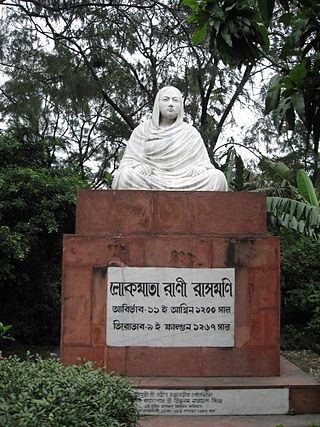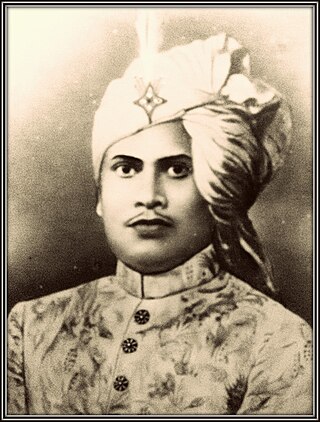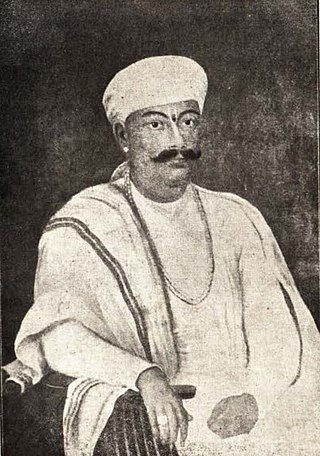
Presidency University, Kolkata is a public state university located in College Street, Kolkata. It was among the best colleges in the country when the institute was affiliated to University of Calcutta. The institution was elevated to university status in 2010 after functioning as a constituent college of the University of Calcutta for about 193 years. Currently, it continues to rank among the top universities in India. The University boasts an illustrious list of extraordinary alumni over the last two centuries, including several pioneers of the Bengal Renaissance, leaders of the Indian Independence Movement, heads of state, noble laureates, Academy Award winner etc.
Jhargram is a planned city and a municipality in the Indian state of West Bengal. It is the headquarters of the Jhargram district. It is a popular tourist destination known for its forests, ancient temples and royal palaces.

Rashmoni Das, popularly known as LokamataRani Rashmoni, also spelled as Rani Rasmani,, was an Indian businesswoman, entrepreneur, Zamindar, philanthropist and the founder of the Dakshineswar Kali Temple in Kolkata. She remained closely associated with Sri Ramakrishna Paramhansa after she appointed him as the priest of the Dakshineswar temple. She was also one of the earliest social reformers in early nineteenth-century Bengal and was one of the forerunners of the Bengal Renaissance. Besides, she also led many of the resistances against the encroaching British administration and their presence in all walks of colonial society in the Bengal province. Her other construction works include the construction of a road from Subarnarekha River to Puri for the pilgrims, Babughat, Ahiritola Ghat and Nimtala ghat for the everyday bathers at the Ganges. She also offered considerable charity to the Imperial Library, and the Hindu College.

The Bardhaman Raj, also known as Burdwan Raj, was a zamindari Raja estate that flourished from about 1657 to 1955 in the Indian state of West Bengal. Maharaja Sangam Rai Kapoor, a Khatri from Kotli, Punjab, who was the first member of the family to settle in Bardhaman, was the original founder of the house of Bardhaman, whereas his grandson Abu Rai, during whose time the zamindari started flourishing, is considered to be the patriarch of the Bardhaman Raj family.

Posta is a neighbourhood in North Kolkata, in Kolkata district in the Indian state of West Bengal. Once a citadel of Bengali mercantile aristocracy, it is now an extension of the whole sale market in neighbouring Burrabazar, dominated by Marwaris. The wholesale market features a wide range of products such as edible oil, salt, cereals, spices, food grains, sugar, and vanaspati products.

Shobhabazar is a neighbourhood of North Kolkata, in Kolkata district, in the Indian state of West Bengal.

Raja Digambar Mitra (1817–1879) was one of the leading Derozians and first Bengali Sheriff of Kolkata.
Sheoraphuli is a neighbourhood of Hooghly district in the Indian state of West Bengal. It is on West side of river Hooghly. It is a part of the area covered by Kolkata Metropolitan Development Authority (KMDA).

Rajbalhat is a census town in Jangipara CD Block of Srirampore subdivision in Hooghly district in the Indian state of West Bengal. Rajbalhat can be reached conveniently by Bus from Kolkata, Haripal or Tarakeswar.

The Jhargram Raj Palace is the current residence of the Malla Deb royal family. Situated in Jhargram district, West Bengal. About 14 rooms on the ground floor have been converted into a Heritage Hotel run by the family.

Zamindars of Natore were influential aristocratic Bengali Zamindars, who owned large estates in what is today Natore District in Bangladesh .

Shobhabazar Rajbari is the palace of the Shobhabazar royal family located in the Indian city of Kolkata.

The Sheoraphuli Raj Debuttar Estate or Sheoraphuli Rajbari was part of the Zamindari of the Sheoraphuli Raj, a branch of the erstwhile Patuli Rajbansha which occupies a very high place in the peerage of Bengal. The Calcutta Review for 1845 states the Sheoraphuli family is "descended from one of the most ancient and respected families in Bengal".

Narasingha Malla Deb, O.B.E. was a member of the Parliament of India and the 18th Raja of Jhargram, which he led from 1916 until the abolition of zamindaris by the West Bengal State Acquisition and Tenancy Act of 1950.
Jharia Raj / Jharia Estate was a Zamindari estate in British India, located at Jharia in Bihar province of the Bengal Presidency.

Narajole is a village and gram panchayat in Daspur I CD Block in Ghatal subdivision of Paschim Medinipur district in the state of West Bengal, India.

Raja Gopi Mohan Tagore (1760–1819) was scion of the Pathuriaghata Tagore family and noted zamindar and philanthropist from Bengal region of the Indian subcontinent.
Sir Maharaja Bahadur Narendra Krishna Deb was a scion of Sovabazar Raj family and a noted citizen of his time.

Jhargram Raj was a zamindari which occupied a position in Bengal region of British India. The zamindari came into being during the later part of the 16th century when Man Singh of Amer was the Dewan/Subahdar of Bengal (1594–1606). Their territory was centered around present-day Jhargram district. Jhargram was never an independent territory since the chiefs of the family held it basically as the zamindars of the British Raj in India after Lord Cornwallis's Permanent Settlement of 1793. Although its owners were both rich and powerful, with the chiefs of the family holding the title of Raja, the Jhargram estate was not defined as a Princely State with freedom to decide its future course of action at the time of Indian independence in 1947. Later, the Vice-Roy of India agreed to recognize Jhargram as "Princely State" after the Second World War, but the proposal taken back as the British had decided to give independence to India.
The Narajole Raj was a medieval royal dynasty and later a zamindari (estate) during the British period at Narajole in Paschim Medinipur district in the state of West Bengal. The Raja of Narajole was one of the largest landholders in Midnapore. The kings of Narajole belonged to the Sadgope community and had a close link with the rulers of Karnagarh.















